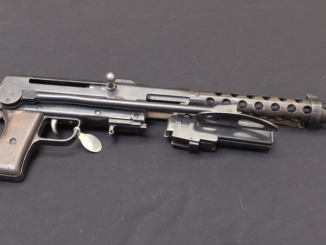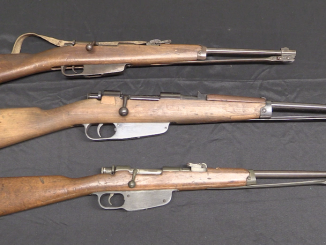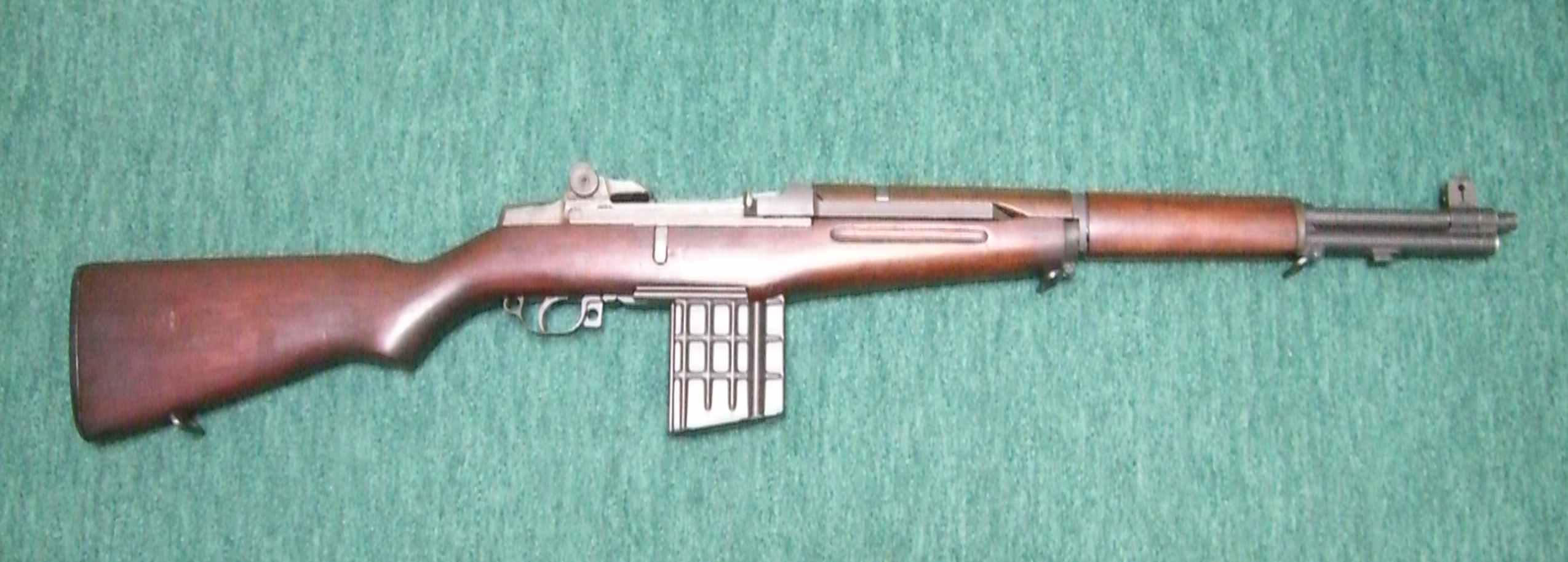This rifle is lot #1415 in the upcoming April 2019 Morphy auction.
When Prussia and its Dreyse needle fire rifles defeated Austria and its muzzleloaders at Shadow in 1866, much of the world took note. In Italy, the reactive was to immediately begin looking for both a new rifle and also a system for converting existing stockpiles of muzzleloaders into something more modern. After considering separate-primer systems like the Albini, Manceaux, and Lindner; metallic cartridges, and needle fire cartridges, the Italians decided upon Salvatore Carcano’s needle fire system as the idea solution.
Reusing the existing muzzleloader barrels meant a caliber of 17.5mm, and needle fire paper cartridges were substantially lighter than metallic cartridges of that size. The needle fire system could still fire an impressive 8 shots per minute, and at less than 10 Lira per gun, the conversion was affordable.
Carcano’s system was based on the Doersch-Baumgarten needle fire system, which was in itself an improvement on the Dreyse. The rear end of an existing muzzleloader barrel was cut away and a bolt added to the gun. While it is an unorthodox type of firing system, Carcano’s design incorporates multiple safety mechanisms and is remarkably good for its cost. The first conversions were made in 1867, with 18,000 guns for the Bersaglieri. This was followed by conversions for the Carabinieri in 1869 and for the Artillery in 1871. This example, like most of the surviving ones, is an 1844/67 Artillery type. These guns were never used in a major conflict, and most were eventually scrapped, leaving them pretty rare today.




Genius is not limited to the famous. Did the artillery guys stack their weapons while working the big muzzle-loaded guns? I can’t imagine anyone lugging around powder bags, rammer, and shot with a carbine slung over the shoulder.
It depended. Siege arty crews did indeed stack arms, because they rarely had to worry about the enemy getting close enough for them to need them.
Field artillery was a different story. Remember, back then field arty was direct-fire, in TIC (Troops In Contact) support. Meaning, they were right up in the front line with the infantry, at best about 50 yards back.
They could expect that in an enemy assault, they would be some of those being close-assaulted. Hence, they kept their carbines handy, and by the 1850s and 1860s, mostly wore holstered, loaded revolvers as well.
Although in the end, they relied mostly on the gun, the field piece. Loaded with canister, it could do a lot more damage to enemy infantry or cavalry out to about 300 yards than small arms could.
(Also more than the mechanical “machine guns” of the time. And a field piece was a lot cheaper than a Gatling gun. now you know why we fought the Civil War with a couple of thousand 12-pounder Napoleons, and only bought a total of twenty-two Gatling guns, ten of them the “personal property” of Gen. Ben Butler.)
The artilleryman’s opinion of “close-quarter battle” was summed up by Ian Hogg (Master Gunner, Royal Artillery):
Or in other words, the “redlegs” will be found gathered around the nearest piece of ordnance that they can still kill you with.
cheers
eon
That’s WHY artillery were issued carbines (often “carbines” that were shorter than the cavalry were issued) — so they could theoretically work with slung guns.
Every day new story is refreshing and is greatly appreciated. One does not need to comment, but still, it is fun to read. I do not know what the person the other day wanted to “improve” on this channel.
I look forward to seeing that commentor putting their ideas into action…
I can’t think of anyone else on the planet who’s capable of producing a daily output with the depth of knowledge and the friendly presentational style that Ian does.
And I can’t think of a site that attracts a higher level of commentariate.
I like what Othias and Mae present as well, and it’s great that all three have teamed up for projects.
Improving on Ian’s excellence would be great to see, but I won’t try to hold my breath while I wait for it 😉
Just like in anything, competition is high and merciless. Even in something like this which looks on surface like fun. There is couple of good ones out there but nobody like FWs.
To do a new number every day means to do solid preparation. Who in past studied knows what I talk about. Some do not understand it a ask Ian ‘questions’. Oh well 🙂
As Ian refers to Battle of Sadowa (Sadova), which is also known as Battle of Koniggratz (today Hradec Kralove), it perhaps may be of use to add this reference
http://www.koniggratz1866.eu/Welcome.html
There is a folk song related to fictitious cannoneer Yaboorek (Jaburek in Czech)who kept loading and firing his gun although he lost all his limbs in process. It is meant as a testimony of Czech contingent’s loyalty to the Empire.
It is worth noting that Königgrätz battle inspired Piefke to create Königgrätzer Marsch, for history see: https://en.wikipedia.org/wiki/K%C3%B6niggr%C3%A4tzer_Marsch
If you want to hear it: https://vimeo.com/306691826
Sounds ok, but too militaristic to my sensibility 🙂
This is more what I like https://en.wikipedia.org/wiki/Radetzky_March
https://www.youtube.com/watch?v=eab_eFtTKFs
yeah, that’s my cup of tea (glass of wine)!
I can see someone making a rifle based on this system today in their home garage, including making their own black-powder paper cartridges.
“These guns were never used in a major conflict, and most were eventually scrapped”
Was that standard procedure in Kingdom of Italy at that time?
Well, perhaps the guns were worn out and not likely to make profit if sold to the public. Plus the likelihood of paper cartridges sold privately in the kingdom were a bit slim (unless you ask folks to make their own primer caps). I could be wrong.
According to an Italian wr site re, Carcanos, they wete indeed “sold to individusls”.
I suppose that needlefired papercartridge guns were somewhat hard to sell due to them being quite obsolete because of the introduction of metallic cartridges.
Thanks for the correction!
They were replaced by more modern rifles, i.e the Carcano M1891.
Correction, about 2 years later by the Vetterli Rifle.
Well, not in a major conflict, but this needle guns armed the Bersaglieri who battled in Rome in 1870, during the third indipendence war who annex the Papal States to Italy. So, this REALLY is a historical gun
100 meter zero? That’s remarkably sane for something of that era.
Really though, the most interesting thing about this it’s an open bolt bolt action. Any others?
“remarkably sane”
This is hint that Carcano or whoever was responsible for that, either has practical experience or dared to consult someone with relevant experience.
I gather that a lot of Carcano needle fires were converted to cheap shotguns.
I try to get the local gun dealer to give me a call when he gets an old bolt action shotgun in, but he still invariably gives them to the cops to be scrapped…
However hard we try, people still treat old guns converted to shotguns, worse than “hovna” (hope I got the spelling correct).
My father has a Gras converted to 12g, that his grandfather owned. It had a dent in the barrel that a friend of my father’s promised to sort out in the 19 70s. The idiot hacksawed the bit of barrel with the dent in it, off!
The odds really were stacked against them surviving.
I would absolutely love to have a Carcano needle fire!
Until this video, I didn’t realise that the bolt face was a seperate, screwed on piece.
It makes a lot of sense, allowing the breech gap to be adjusted during conversion and again if gas leakage or setback of the one locking surface causes it to increase. It also allows for easy replacement if erosion or corrosion cause gas leakage to occur down the needle hole.
Even with the replaceable bolt face, it still shows that Carcano was ahead of both Mauser and Schlegelmilch, with the idea of a bolt that was drilled from the rear.
I’m a huge fan of Carcano’s ideas about safeties. I really do think that he was far ahead of everyone else, i think that removing the spring tension is absolutely the right way to go about it.
The seperate half cock sear is a piece of brilliance as well.
The idea of being able to easily remove the innards from the bolt as a unit, is necessary and brilliant.
Needle fires were prone to gas leakage into the bolt.
Being able to disassemble the bolt so easily, means that there’s no excuse for not dropping both bits into a pot of boiling water, to remove any corrosive debris, and properly drying and oiling the parts at the end of a day of firing.
A bit outside the subject but there is a company here in France that sells a bolt conversion kit to shoot metellic cartriges in the chassepot http://www.hc-collection.com